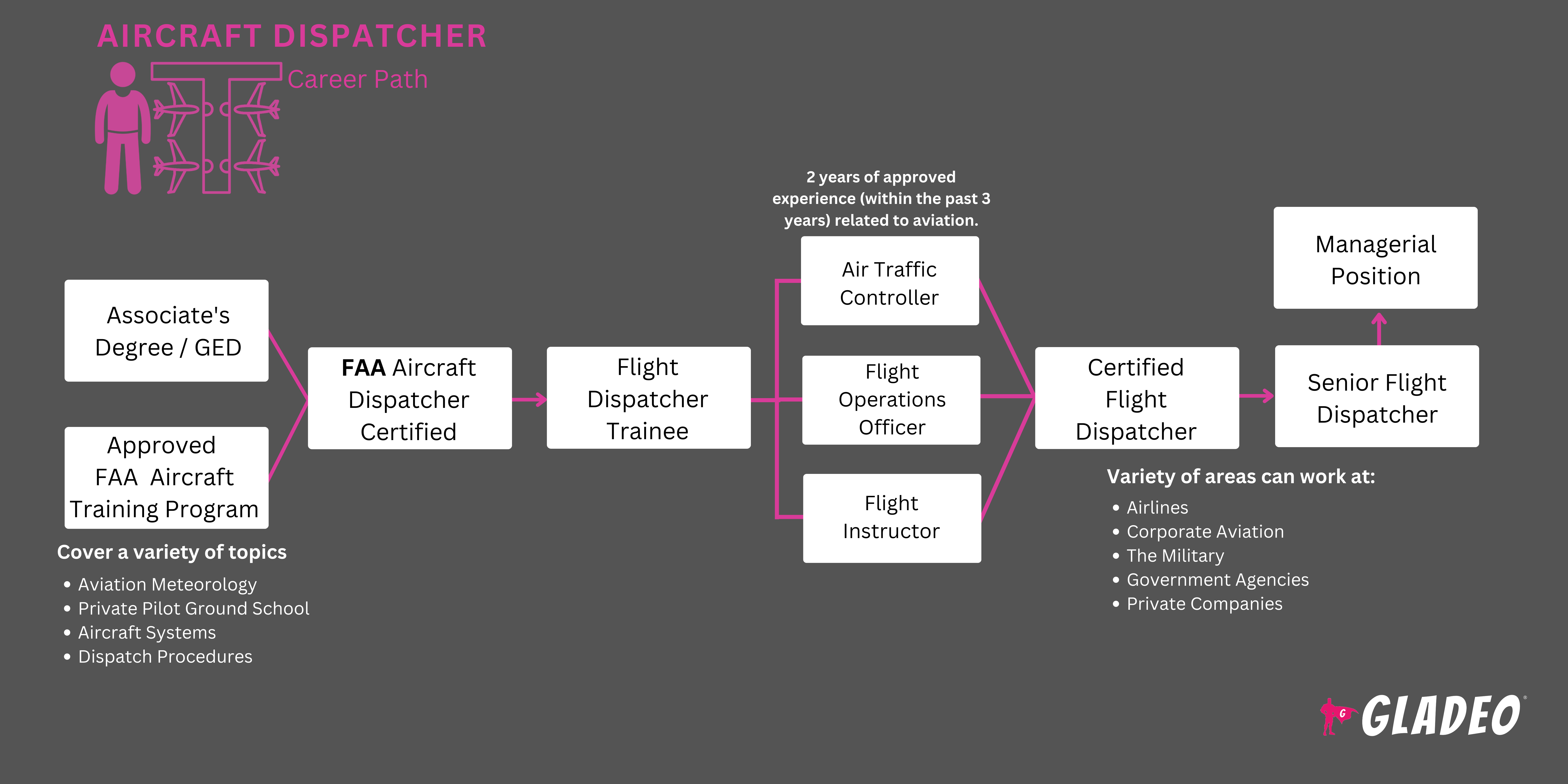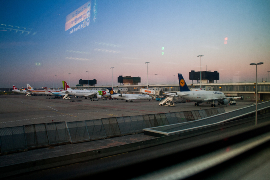Focos de atención
Flight Operations Coordinator, Aviation Operations Planner, Flight Dispatcher, Aviation Scheduler, Aircraft Operations Coordinator, Flight Planning Specialist, Air Traffic Control Coordinator, Flight Logistics Manager, Aircraft Routing Coordinator
When we want to travel to someplace far away, we often think about flying on an airplane. But it’s not as simple as just hopping on a flight and taking off! Unlike traveling by car, travel by commercial airplane requires the combined efforts of many people—including Aircraft Dispatchers (also known as flight dispatchers).
Aircraft Dispatchers help create the planned flight paths pilots follow to avoid hitting objects and other planes. This involves continuously examining weather and airport conditions along the route, to ensure flights can travel safely. In addition, Dispatchers calculate the aircraft’s weight with fuel, cargo, and passengers, and they monitor how the aircraft and crew are performing while in flight.
Aircraft Dispatchers work directly for the airline that employs them. They share legal responsibility with the pilots in command of each flight. They are not the same as Air Traffic Controllers, but they do work together to ensure flights are tracked and pilots are informed of changes!
- Keeping aircraft and passengers safe
- Ensuring passengers can reach their travel destinations
- Being part of a global industry that manages ~100,000 flights per day
Horario de trabajo
- Aircraft Dispatchers work full-time jobs and may work nights, weekends, and holidays. Work conditions involve being “surrounded by people, teletype machines, telephones, and intercom systems in a noisy, busy atmosphere. Those who work for a small airline, carry on the duties of a meteorologist and schedule coordinator.”
Tareas típicas
- Review weather conditions and air traffic to create flight plans for aircraft pilots to follow
- Ensure plans maximize efficiency so flights can travel the shortest routes possible, saving both time and fuel
- Continuously monitor weather conditions as aircraft proceed along their paths
- Monitor conditions at any airports where flights will land, including for layovers and emergency stops
- Monitor aircraft and crew performance; work with air traffic controllers to track planes along their routes
- Stay in communication with air traffic controllers and flight crew to relay information, such as turbulence warnings
- Determine fuel requirements for flights based on the aircraft’s weight calculated with passengers, cargo, and fuel, as well as the distance being flown and the effect of wind resistance
- Document flight plans and relevant reports in compliance with airport, airline, and Federal Aviation Administration rules
Responsabilidades adicionales
- Coordinate with airport authorities and investigators as needed
- Assist flight crew during emergencies to ensure appropriate safety actions are taken
- Keep ground crew up to date on instructions and changes related to inbound flights
- Stay updated on applicable FAA, airport, and airline regulations and policies
- Complete at least five hours of annual “familiarization flights” in the cockpit jumpseat
Habilidades blandas
- Atención al detalle
- Calma bajo presión
- Decisivo
- Orientado a objetivos
- Iniciativa
- Integridad
- Multitarea
- Organización
- Paciente
- Resolución de problemas
- Gran capacidad de comunicación
- Task prioritization
- Trabajo en equipo
- Gestión del tiempo
Habilidades técnicas
- Aircraft fuel consumption rates
- Aircraft navigation/flight planning software
- Aircraft technical systems
- Airspace utilization
- Air Traffic Control communication programs
- Domestic and Global Navigation Systems
- Flight operations, planning, and safety
- Knowledge of Federal Aviation Administration regulations
- Meteorological Terminal Aviation Routine Weather Report (METAR)
- North Atlantic Track System
- NOTAMs
- Pilot Reports
- Safety and emergency standards and procedures
- Terminal Area Forecasts
- Understanding of aircraft performance
- Weather analysis and interpretation software
- Aerolíneas
- Flight operations companies
- Large freight carriers
Aircraft Dispatchers bear great responsibility regarding flight and passenger safety, including legal responsibilities that they share with aircraft commanders. They have a wide range of duties to perform with little to no margin for error.
It can be a high-pressure job involving daily critical decisions and occasional emergencies, all of which are time-sensitive. The workload can get heavy and work schedules include nights, weekends, and holidays, making it tough for those with family lives.
That said, Aircraft Dispatchers can receive many perks, such as “Cockpit Jumpseat Authority (ride jumpseat on your airline, and most other airlines globally),” as well as other employment benefits.
The airline industry is always facing new challenges and adapting to new technologies. A few trends that affect Aircraft Dispatchers specifically include automation via advanced flight planning systems and weather monitoring software, which is helpful but requires additional training to get up to speed on.
Another trend, if it can be called that, is the fact that weather patterns are changing, necessitating Aircraft Dispatchers to stay increasingly vigilant. Meanwhile, there is always a demand for improved safety measures, more efficient operations, and better Crew Resource Management.
Aircraft Dispatchers are often aviation fans who may have enjoyed learning about the industry from an early age. Some are general aviation hobbyists; others are into real-life flying and have earned private pilot licenses.
In addition to having knowledge and skills related to aircraft operations, dispatchers have a range of skills they likely developed in school, such as decisiveness, clear communication, the ability to multitask, and staying calm under pressure. These skills could have been picked up from playing team sports or engaging in extracurricular activities with others.
- Aircraft Dispatchers complete their training at a dispatcher school or program
- English fluency is required, along with a high school diploma or equivalent
- No prior knowledge of aviation is needed. A college degree is not required (though some earn a degree in aviation, air transportation, or meteorology)
- Dispatcher programs must be approved by the FAA. Training time consists of 200 hours of instruction
- Some programs may feature portions of the training online
- Full-time students attend training for 5-6 weeks, including field trips to airline operational control centers. Classes last for several hours a day. All training hours must be logged
- Training topics include:
- Aeronautical decision-making
- Aircraft performance
- Air navigation during meteorological conditions
- Air traffic control procedures
- Crew resource management
- Meteorology
- Weather and Notices to Airmen
- Weight calculations
- Those who have already completed some relevant training can ask to reduce the number of training hours required for their certification
- To earn an FAA dispatcher license, students must pass three exams:
- An 80-question FAA Aircraft Dispatcher (ADX) test. You must be at least 21 to take the test and at least 23 to qualify for licensure. Test-takers must score at least a 70%
- A practical exam based on a real-life simulated flight plan (or, as Sheffield School of Aeronautics explains it, a “hands-on test in which you will have to demonstrate that you have mastered flight planning, emergency protocols, pre-flight and departure routines, in-flight practices, landing regulations, and post-flight routines”
- A verbal test in which test-takers must answer questions from an FAA-designated examiner
- Some Aircraft dispatchers gain experience as “dispatch clerks, junior flight dispatchers, radio operators, meteorologists, or station managers”
- To become an Aircraft Dispatcher, students must complete an FAA-approved training program at any educational institution offering one. It doesn’t have to be at a college or university. Programs may take 5 to 6 weeks.
- Compare siempre los costes de matrícula y otras tasas, y revise sus opciones de becas y ayudas económicas.
- High school students should take plenty of courses in English, communications, information technology, general math, and physics
- Completion of an FAA-approved Aircraft Dispatcher training program will teach students everything they need to know. Some students opt to go to college to study aviation or meteorology, but a college degree isn’t necessary and won’t qualify graduates to enter this field unless they complete the training and pass the three exams (ADX, practical, and verbal exams)
- Read up on the career field, and the responsibilities. Be sure this is something you want to get into!
- Ask a working Aircraft Dispatcher if they’ll do an informational interview with you
- Participate in aviation programs for high school students, such as:
- Academia de Aeromodelismo
- Civil Air Patrol (CAP) Aerospace Education Program
- Experimental Aircraft Association (EAA) KidVenture Program
- FAI Young Artists Contest
- Organization of Black Aerospace Professionals (OBAP)
- Women in Aviation International (WAI)
- Youth Aviation Adventure (YAA)
- Check out additional STEM Aviation and Space Education partnerships and FAA industry affiliate programs

- The main criteria for qualifying for a job is to have your FAA Aircraft Dispatcher license, which is the certification needed to work
- To get that license, you must:
- Finish the mandatory 200 hours of training (unless some hours are waived due to prior training)
- Be at least 23 years old
- Be a high school graduate or equivalent
- Be proficient in English (reading, writing, and communicating)
- Take and pass three exams—the ADX, a practical flight planning test, and an oral exam. You must be at least 21 years old to take the ADX
- In addition to having your license, having a degree in aviation or meteorology may give you an advantage over other candidates
- Check out job portals like Indeed.com, as well as Aeroindustryjobs, AerospaceCrossing, American Institute of Aeronautics and Astronautics, Avjobs, and Aviation Job Search
- Speak with your training program school to ask about help finding a job. Some schools may partner with employers and be able to connect you to a recruiter
- Ask people you know in the industry for tips or connections that could help you
- Ask teachers and trainers if they’re willing to serve as personal references or write testimonials about your abilities
- Remember, many towns don’t have airports and you don’t want to commute hours a day to get to work! So you might have to move once you get hired
- Aircraft Dispatchers often start working for small airlines and then either get promoted from within or apply to work for larger airlines
- Larger airlines may offer greater promotion opportunities. They may also employ “senior dispatchers who specialize in coordinating the finances of every flight”
- Let your supervisor know that you’re interested in career progression. Ask them for advice on what you can do to make yourself a more valuable asset
- Workers in this field may also work their way up, through gaining experience and additional education and training, to work as FAA air traffic controllers (ATC) or even airport directors
- For example, to become an ATC, you’d need to finish an FAA-approved Air Traffic Collegiate Training Initiative program (along with passing a medical exam, background check, FAA pre-employment tests, and training at the FAA Academy)
- Other related roles that you might advance into include operations manager, flight operations supervisor or director, or airline management jobs such as fleet manager or executive positions
- Do your best to train and mentor others and hold them to the highest standards
- Continue to work on your education and training. Stay up to date on the latest regulations, policies, and procedures, as well as new and upgraded software
- Be active in professional organizations such as the Aircraft Dispatchers Federation. Grow your network and you’ll increase your odds of advancing!
Páginas web
- Aircraft Dispatchers Federation
- Civil Air Patrol (CAP) Aerospace Education Program
- Experimental Aircraft Association (EAA) KidVenture Program
- Federal Aviation Administration
- Asociación de Transporte Aéreo Internacional
- International Civil Aviation Organization
- International Federation of Airworthiness
- National Air Transportation Association
- National Business Aviation Association
- Organization of Black Aerospace Professionals (OBAP)
- Women in Aviation International (WAI)
- Youth Aviation Adventure (YAA)
Libros
If a career as an Aircraft Dispatcher seems too hectic, but you’re still interested in the aviation industry, below are a few more options to consider!
- Aircraft Fueler
- Aircraft Mechanic
- Airline and Commercial Pilot
- Cabin Maintenance Mechanic
- Ground Attendant
- Meteorólogo
- Passenger Service Agent
- Ramp Service Personnel
- Reservation Sales Agent
- Sky Cap
- Ticket Agent
- U.S. Air Force officer
Newsfeed

Trabajos destacados

Cursos y herramientas en línea

Expectativas salariales anuales
New workers start around $42K. Median pay is $50K per year. Highly experienced workers can earn around $61K.





